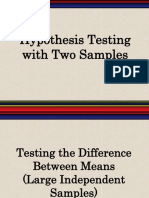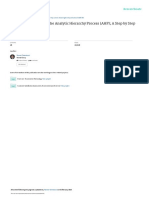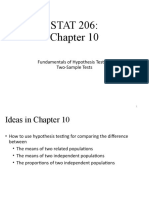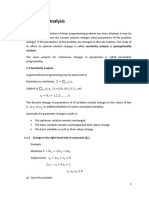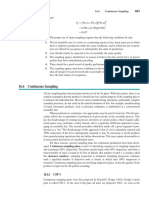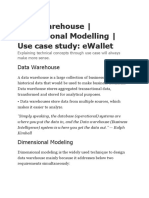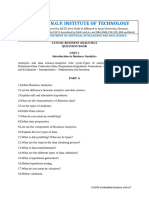QC Module6
Uploaded by
Rafly Galih SaputraQC Module6
Uploaded by
Rafly Galih SaputraProcess Capability
Module 6 – Quality Control
TMA@2008
Learning Outcomes
After completing this module, you will be able to:
Understand the concep of process capability and its
importance for quality control
Measure and analysis the process capability of a given
process
Module 6: Process Capability 2
TMA@2008
Introduction
Variability in the process
is a measure of the uniformity
of output
Two ways to think of this variability:
1.Natural or inherent variability in a
critical-to-quality characteristic at a
specified time (instantaneous)
2.Variability in a critical-to-quality
characteristic over time
Process capability
refers to the uniformity of the
process
Module 6: Process Capability 3
TMA@2008
It is customary to take the six-sigma spread in the
distribution of the product quality characteristics as a
measure for process capability
Module 6: Process Capability 4
TMA@2008
Process capability analysis is an engineering
study to estimate process capability.
In the form of probability distribution (shape)
Center (mean)
Spread (standard deviation)
Module 6: Process Capability 5
TMA@2008
Uses of process capability data:
Predicting how well the process will hold the tolerances.
Assisting product developers/designers in selecting or
modifying a process.
Assisting in Establishing an interval between sampling for
process monitoring.
Specifying performance requirements for new equipment.
Selecting between competing vendors.
Planning the sequence of production processes when there is
an interactive effect of processes on tolerances.
Reducing the variability in a manufacturing process.
Module 6: Process Capability 6
TMA@2008
Techniques used in process
capability analysis
Module 6: Process Capability 7
TMA@2008
Histogram Plot
The histogram along with the sample mean and
sample standard deviation provides information
about process capability.
The process capability can be estimated as:
x 3s
The shape of the histogram can be determined
(such as if it follows a normal distribution)
Histograms provide immediate, visual
impression of process performance.
Module 6: Process Capability 8
TMA@2008
Example
Module 6: Process Capability 9
TMA@2008
x 264.06
s 32.02
Process capability:
264.06 + 3(32.06) 264 + 96
It means that approximately 99.73% of the bottle
manufactured by this process will burst between
168 to 360 psi
Module 6: Process Capability 10
TMA@2008
Process Capability Ratio
A convenient, simple and qualitative way to express
process capability
If USL = Upper Specification Limit
LSL = Lower Specification Limit
Then, process capability ratio is:
USL LSL
Cp
6
Module 6: Process Capability 11
TMA@2008
If the standard deviation is not known; it can be
estimated by calculating
̂ S or R / d2
The process capability ratio
USL LSL
Ĉ p
6ˆ
Module 6: Process Capability 12
TMA@2008
Example
Module 6: Process Capability 13
TMA@2008
Module 6: Process Capability 14
TMA@2008
Process Capability Ratio:
USL LSL
Ĉ p
6ˆ
ˆ 2.00 1.00
Cp 1.192
6(0.1398)
Useful practical interpretation:
1 1
P
C
100
P 100 83.8
p 1.192
Percentage of specification used up by the process:
83.8%
Module 6: Process Capability 15
TMA@2008
One-sided Process Capability
Ratio
For one-sided specification (upper or lower
specification limit only):
USL
C pu
3
LSL
C pl
3
Module 6: Process Capability 16
TMA@2008
Interpretation of PCR
The greater the
value of Cp the
process getting
more capable
Module 6: Process Capability 17
TMA@2008
Assumptions for Interpretation
If any of these
assumptions
are violated,
the resulting
quantities may
be in error
Module 6: Process Capability 18
TMA@2008
Recommendations
Module 6: Process Capability 19
TMA@2008
Process Capability Ratio and Off-
Center Process
Cp does not take process
centering into account
It is a measure of
potential capability, not
actual capability
Module 6: Process Capability 20
TMA@2008
A Measure of Actual Process
Capability
A process capability ratio that does take into account
centering is Cpk defined as:
Cpk = min(Cpu, Cpl)
Module 6: Process Capability 21
TMA@2008
Interpretations of Cpk
Module 6: Process Capability 22
TMA@2008
Cpk alone is still an inadequate measure of process
centering
Cpk must be compared to Cp.
Module 6: Process Capability 23
TMA@2008
Example
Module 6: Process Capability 24
TMA@2008
Example
Module 6: Process Capability 25
TMA@2008
The Use of Control Chart and Cpk
It is recommended to use the control chart and
calculate the process Cpk for better understanding of
the process and to able to control the process properly
On every sample, calculate standard deviation and
then mean of the sample. Use it for control chart.
Calculate Cpk
Module 6: Process Capability 26
TMA@2008
LSL Spec USL
Capable and centered
Capable, but not centered
Not capable, and
not centered
Module 6: Process Capability 27
TMA@2008
Example
Module 6: Process Capability 28
TMA@2008
• Since LSL = 200
Process in control but not capable
Module 6: Process Capability 29
TMA@2008
Normal Assumption
The normal distribution of the process output is an
important assumption
If the distribution of the process output is not normal
then the formula cannot be used
Other process capability indices must be employed
Module 6: Process Capability 30
You might also like
- Chapter 9 Appendix: Acceptance Sampling Fundamentals100% (1)Chapter 9 Appendix: Acceptance Sampling Fundamentals11 pages
- 2.1 Anatomical & Mechanical Structure of HumansNo ratings yet2.1 Anatomical & Mechanical Structure of Humans53 pages
- Perceptions of The Stem Student in Taking The Engineering Course0% (1)Perceptions of The Stem Student in Taking The Engineering Course70 pages
- Chapter 06-Statistical Methods in Quality Management: True/FalseNo ratings yetChapter 06-Statistical Methods in Quality Management: True/False20 pages
- EDA-HYPOTHESIS-TESTING-FOR-TWO-SAMPLE (With Answers)No ratings yetEDA-HYPOTHESIS-TESTING-FOR-TWO-SAMPLE (With Answers)6 pages
- Sample Problem With Answers On Hypothesis TestingNo ratings yetSample Problem With Answers On Hypothesis Testing3 pages
- Decision Making Using The Analytic Hierarchy Process (AHP) A Step by Step ApproachNo ratings yetDecision Making Using The Analytic Hierarchy Process (AHP) A Step by Step Approach4 pages
- Assignment 3: Raj Desai CMGT 6660 - Quality Control SystemsNo ratings yetAssignment 3: Raj Desai CMGT 6660 - Quality Control Systems6 pages
- STAT 206 - Chapter 10 (Two-Sample Hypothesis Tests)No ratings yetSTAT 206 - Chapter 10 (Two-Sample Hypothesis Tests)38 pages
- SPC Charts - Statistical Process Control Charts PDFNo ratings yetSPC Charts - Statistical Process Control Charts PDF6 pages
- Linear Programming Models: Graphical and Computer Methods: To AccompanyNo ratings yetLinear Programming Models: Graphical and Computer Methods: To Accompany92 pages
- Unit 7 Single Sampling Plans: StructureNo ratings yetUnit 7 Single Sampling Plans: Structure30 pages
- Probability Distribution: Shreya Kanwar (16eemme023)No ratings yetProbability Distribution: Shreya Kanwar (16eemme023)51 pages
- Lecture 11 Binomial Probability DistributionNo ratings yetLecture 11 Binomial Probability Distribution10 pages
- 18MEO113T - DOE - Unit 4 - AY2023 - 24 ODD100% (1)18MEO113T - DOE - Unit 4 - AY2023 - 24 ODD65 pages
- Statistical Process Control Exercise For Exam TwoNo ratings yetStatistical Process Control Exercise For Exam Two4 pages
- Analyze Phase: The Aim of The Analyze Phase Is ToNo ratings yetAnalyze Phase: The Aim of The Analyze Phase Is To49 pages
- Ch12 Factorial and Fractional Factorial Experiments For Process Design and ImprovementNo ratings yetCh12 Factorial and Fractional Factorial Experiments For Process Design and Improvement81 pages
- OPERTIONS RESEARCH Note From CH I V Revised PDF100% (1)OPERTIONS RESEARCH Note From CH I V Revised PDF145 pages
- Biometrika Trust, Oxford University Press BiometrikaNo ratings yetBiometrika Trust, Oxford University Press Biometrika22 pages
- Quantitative Methods For Decision Making: Dr. Tanvir AbirNo ratings yetQuantitative Methods For Decision Making: Dr. Tanvir Abir35 pages
- Process Capability Six Sigma Version 1 PDFNo ratings yetProcess Capability Six Sigma Version 1 PDF32 pages
- Lecture 6 Process Capability, Specification Limits and TolerancesNo ratings yetLecture 6 Process Capability, Specification Limits and Tolerances50 pages
- Handbook On Writing Laboratory Reports: Department of ChemistryNo ratings yetHandbook On Writing Laboratory Reports: Department of Chemistry34 pages
- The Impact of Practical Work On The Teaching and Learning of Some Concepts in Biology in Some Selected Secondary SchoolsNo ratings yetThe Impact of Practical Work On The Teaching and Learning of Some Concepts in Biology in Some Selected Secondary Schools60 pages
- Adoption and Outcomes of ISO 14001 - A Systematic Review VER 22.01 20No ratings yetAdoption and Outcomes of ISO 14001 - A Systematic Review VER 22.01 2023 pages
- Chapter 10-Statistical Inference For Two SamplesNo ratings yetChapter 10-Statistical Inference For Two Samples30 pages
- Data Warehouse - Dimensional Modelling - Use Case Study: EwalletNo ratings yetData Warehouse - Dimensional Modelling - Use Case Study: Ewallet7 pages
- B.A. Voronin Et Al - HDO Absorption Spectrum Above 11500 CM - 1: Assignment and DynamicsNo ratings yetB.A. Voronin Et Al - HDO Absorption Spectrum Above 11500 CM - 1: Assignment and Dynamics15 pages
- Statistics for Business and Economics 13th Edition McClave Test Bank all chapter instant download100% (13)Statistics for Business and Economics 13th Edition McClave Test Bank all chapter instant download56 pages
- STA2023 Final Exam Grade Saver Fall 14 (New) Notes PDFNo ratings yetSTA2023 Final Exam Grade Saver Fall 14 (New) Notes PDF36 pages
- Null Model Analysis of Species Co-Occurrence PatternsNo ratings yetNull Model Analysis of Species Co-Occurrence Patterns17 pages
- Chapter 9 Appendix: Acceptance Sampling FundamentalsChapter 9 Appendix: Acceptance Sampling Fundamentals
- Perceptions of The Stem Student in Taking The Engineering CoursePerceptions of The Stem Student in Taking The Engineering Course
- Chapter 06-Statistical Methods in Quality Management: True/FalseChapter 06-Statistical Methods in Quality Management: True/False
- EDA-HYPOTHESIS-TESTING-FOR-TWO-SAMPLE (With Answers)EDA-HYPOTHESIS-TESTING-FOR-TWO-SAMPLE (With Answers)
- Decision Making Using The Analytic Hierarchy Process (AHP) A Step by Step ApproachDecision Making Using The Analytic Hierarchy Process (AHP) A Step by Step Approach
- Assignment 3: Raj Desai CMGT 6660 - Quality Control SystemsAssignment 3: Raj Desai CMGT 6660 - Quality Control Systems
- STAT 206 - Chapter 10 (Two-Sample Hypothesis Tests)STAT 206 - Chapter 10 (Two-Sample Hypothesis Tests)
- SPC Charts - Statistical Process Control Charts PDFSPC Charts - Statistical Process Control Charts PDF
- Linear Programming Models: Graphical and Computer Methods: To AccompanyLinear Programming Models: Graphical and Computer Methods: To Accompany
- Probability Distribution: Shreya Kanwar (16eemme023)Probability Distribution: Shreya Kanwar (16eemme023)
- Ch12 Factorial and Fractional Factorial Experiments For Process Design and ImprovementCh12 Factorial and Fractional Factorial Experiments For Process Design and Improvement
- Biometrika Trust, Oxford University Press BiometrikaBiometrika Trust, Oxford University Press Biometrika
- Quantitative Methods For Decision Making: Dr. Tanvir AbirQuantitative Methods For Decision Making: Dr. Tanvir Abir
- Lecture 6 Process Capability, Specification Limits and TolerancesLecture 6 Process Capability, Specification Limits and Tolerances
- Handbook On Writing Laboratory Reports: Department of ChemistryHandbook On Writing Laboratory Reports: Department of Chemistry
- The Impact of Practical Work On The Teaching and Learning of Some Concepts in Biology in Some Selected Secondary SchoolsThe Impact of Practical Work On The Teaching and Learning of Some Concepts in Biology in Some Selected Secondary Schools
- Adoption and Outcomes of ISO 14001 - A Systematic Review VER 22.01 20Adoption and Outcomes of ISO 14001 - A Systematic Review VER 22.01 20
- Data Warehouse - Dimensional Modelling - Use Case Study: EwalletData Warehouse - Dimensional Modelling - Use Case Study: Ewallet
- B.A. Voronin Et Al - HDO Absorption Spectrum Above 11500 CM - 1: Assignment and DynamicsB.A. Voronin Et Al - HDO Absorption Spectrum Above 11500 CM - 1: Assignment and Dynamics
- Statistics for Business and Economics 13th Edition McClave Test Bank all chapter instant downloadStatistics for Business and Economics 13th Edition McClave Test Bank all chapter instant download
- STA2023 Final Exam Grade Saver Fall 14 (New) Notes PDFSTA2023 Final Exam Grade Saver Fall 14 (New) Notes PDF
- Null Model Analysis of Species Co-Occurrence PatternsNull Model Analysis of Species Co-Occurrence Patterns















